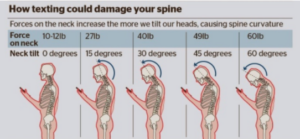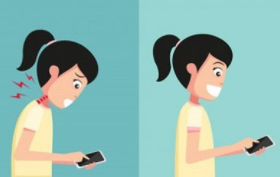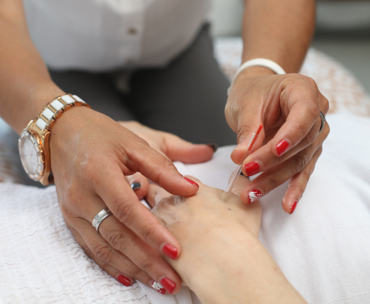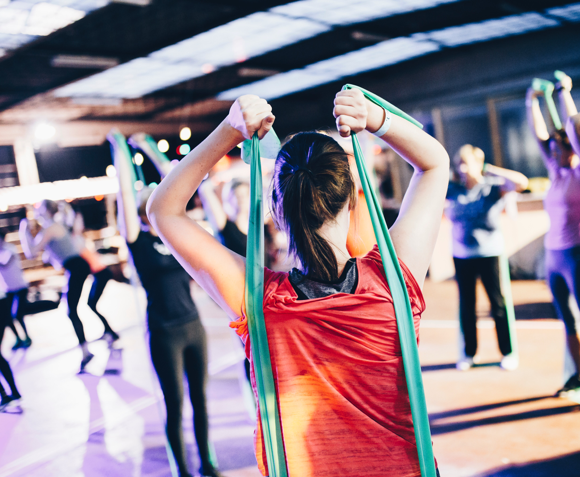Have you been experiencing neck pain, headaches, upper back pain, shoulder pain, and numbness in the hands? Perhaps you have begun to develop some lower back pain? More pressing, maybe you have experienced a rotator cuff tendon or cervical disc injury? If so, you could be suffering from Upper-Crossed Syndrome (UCS).
One of the most common postural imbalances, this syndrome is the result of regularly sitting with a forward head, rounded shoulders, and collapsed chest. If this is a little confusing to imagine, think about how you usually sit at your desk or how you rest when you are scrolling through Facebook or texting on your phone. Did you think of something like this?

If so, you have imagined the perfect picture of the poor posture that leads to UCS.
Think about it this way: for every inch forward the head travels off the central axis of the body, it adds 10lbs of pressure on the vertebrae of the neck and upper back!
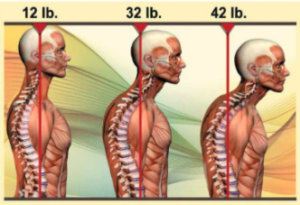
As you can imagine, resting like this for hours on end, day after day can contribute to herniated disks, bone spurs, and other degenerative joint problems. With UCS becoming an epidemic of sorts, it is no surprise that it is one of the more common problems we address in the clinic.
What are the symptoms of Upper Crossed Syndrome?
In UCS, crucial muscles around the neck and chest are shortened and tightened. Simultaneously, other muscles in the upper back and center of the neck are lengthened and inhibited. This pulling and scrunching can cause pain, aching, and burning in the neck and shoulder muscles. In many cases, it can restrict blood flow to the extremities and head, leading to numbness and headaches. This proves to be especially problematic for those who are already susceptible to migraines. Pinched nerves are another unwelcome side effect. Surprisingly, UCS can also lead to fatigue. This comes as a result of the shallow breathing and oxygen deprivation that naturally occurs with collapsed posture.
How can Upper Crossed Syndrome be fixed?
Correct your posture! Sounds simple enough, right? However, this may not be quite as easy as it sounds. After years of living with improper posture, muscle memory takes over. Certain muscles become stuck in a shortened position. Connective tissue fibers become knotted and tight. Plus, the nervous system has a difficult time locating and activating the muscles responsible for correcting posture. Basically, the body is playing a big game of Tug-of-War with little direction and a weakened ability to act efficiently.
While correcting this internal battle can often be a challenge, there are some great tools you can use to help the process along and build greater support and awareness
1. Pilates and Other Corrective Exercises and Stretches
In combination with an increased awareness of poor posture, exercise seems to be the most effective form of treatment and prevention for UCS. Key Pilates exercises work to bring the head back over the central axis, retract the shoulders, and improve alignment of the spine, all leading to a more upright, less damaging position.
In addition, Pilates focuses heavily on increasing strength and awareness of the core, a vital element of perfect posture. By simply increasing awareness of your core and posture and making appropriate corrections in the moment, the effects of UCS can often be dramatically decreased.
2. Chiropractic Adjustments
In combination with proper exercise and stretching, spinal manipulation can mobilize joints. This increased range of motion relaxes the soft tissue, increases range of motion, and relieves pain.
3. Massage and Acupuncture
Acupuncture and massage are especially effective in lengthening connective tissue bands, increasing mind-body awareness and control, releasing tight muscles, and activating dormant ones. Acupuncture is particularly beneficial for relieving pain and increasing blood flow, leading to quicker healing of damaged tissues. In addition, both acupuncture and massage calm the nervous system. This allows for a reduction of stress which is often responsible for increased muscle tension.
Takeaways
Upper-Crossed Syndrome is pervasive in our modern, tech-obsessed society. It can lead to a host of aches, pains, and even some nasty injuries. However, it is certainly preventable and treatable. By combining exercise, chiropractic adjustments, Sports Medicine Acupuncture®, traditional acupuncture, and massage, posture can be corrected, pain can be relieved, and further degenerative injuries of the spine can be prevented.
If you feel you may be experiencing UCS or have concerns about the health of your spine, schedule a consultation with Beverly Hills Posture today!



